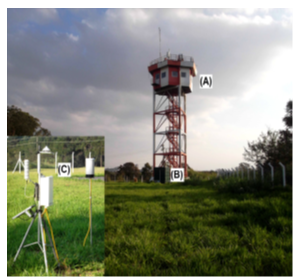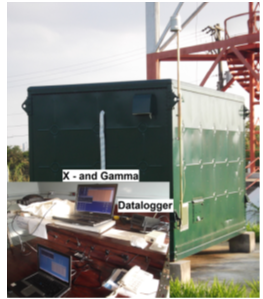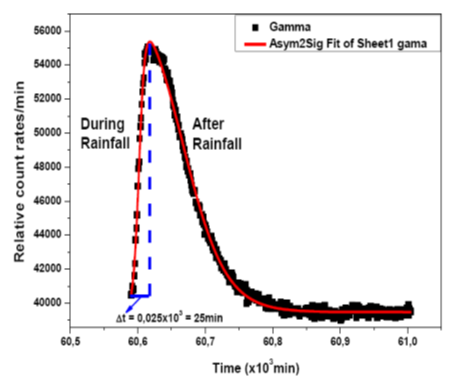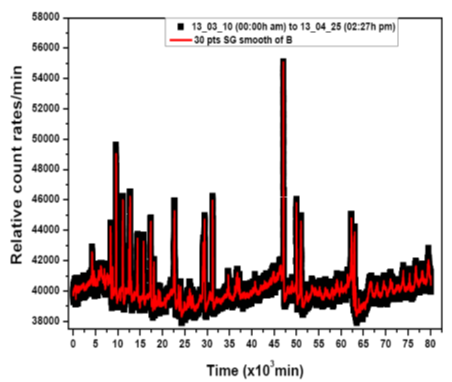-
Paper Information
- Previous Paper
- Paper Submission
-
Journal Information
- About This Journal
- Editorial Board
- Current Issue
- Archive
- Author Guidelines
- Contact Us
World Environment
p-ISSN: 2163-1573 e-ISSN: 2163-1581
2013; 3(4): 138-141
doi:10.5923/j.env.20130304.03
Measurements of X- and Gamma Radiation at Ground Level and their Correlation with Atmospheric Electric Discharges and Rainfall in São José dos Campos, SP, Brazil
Inácio M. Martin1, Marcelo P. Gomes2, Marco A. S. Ferro2, Marcos L. A. Pinto2, Flávio C. Antônio2
1Department Physics, Technological Institute of Aeronautics ITA, São José dos Campos, 12228-900, Brazil
2Division of Atmospheric Sciences, Institute of Aeronautics and Space, São José dos Campos, 12228-900, Brazil
Correspondence to: Marcelo P. Gomes, Division of Atmospheric Sciences, Institute of Aeronautics and Space, São José dos Campos, 12228-900, Brazil.
| Email: |  |
Copyright © 2012 Scientific & Academic Publishing. All Rights Reserved.
The main objective of this study was to determine qualitatively whether there is a correlation between measurements of X - and gamma radiation and the occurrence of atmospheric electric discharges and rainfall in the region of São José dos Campos, SP, Brazil. The intensity of the background noise of the X - and gamma radiation in the energy range of 30 keV to 10 MeV was previously determined at ground level under dryer conditions. After determining the background radiation levels, it was possible to measure the increase in count rates of X - and gamma radiation during the occurrence of intense lightning and rainfall over the region of study (ACA tower/IAE) in Brazil.
Keywords: X - and Gamma Radiation, Atmospheric Electric Discharges, Rainfall
Cite this paper: Inácio M. Martin, Marcelo P. Gomes, Marco A. S. Ferro, Marcos L. A. Pinto, Flávio C. Antônio, Measurements of X- and Gamma Radiation at Ground Level and their Correlation with Atmospheric Electric Discharges and Rainfall in São José dos Campos, SP, Brazil, World Environment, Vol. 3 No. 4, 2013, pp. 138-141. doi: 10.5923/j.env.20130304.03.
1. Introduction
- The intense electric field inside a storm cloud (of the order of 105 V/m) can accelerate free electrons in the atmosphere to relativistic velocities. The electron avalanche resulting from this process may also start from intense electric field generated by lightning discharges. However, the type of radiation created by this mechanism is still unknown. Experiments with detectors placed in aircraft and also in stratospheric balloons registered an increase of gamma radiation during the production of lightning[1]. Detectors located in high mountains recorded events in which gamma rays with energies above 1 MeV were also produced during lightning[2]. Rocket-borne detectors also recorded increases in the intensity of X- and gamma radiation during lightning [3,4]. Based on observations made by satellites, Fishman reported that gamma-ray emissions coincided with the location of storms[5]. In 2007, a group of researchers measured gamma ray events with energies up to 1.0 MeV during storms and lightning events[6]. In Brazil, near Cachoeira Paulista, SP, increases in gamma ray count rate during storms and intense rainfall were also observed[7].
2. Method
 | Figure 1. View of (A) ACA Tower in São José dos Campos, SP, Brazil, (B) instrument trailer, and (C) meteorological station |
 | Figure 2. Trailer and instruments inside the trailer at the ACA Tower. Note the pluviometer at the top of the pole attached to the side of the container |
3. Results
- During the study period, we observed that there was a strong temporal correlation between the increase in the magnitude of the atmospheric electric field due to the presence of storm clouds and increase in X- and gamma count rates (Figure 3).Variations in the electric field caused by the presence of electrified clouds over the study region coincided with an increase in radiation counts. Although it was not possible to quantify the contribution of lightning discharges, increases in gamma radiation counts were recorded during the occurrence of storms (Figure 4).To clarify this problem, it will be necessary to collect additional data on atmospheric electric field variations and the spectra of gamma radiation resulting from the radioactive decay of radon gas before, during and after rainfall since radon is an important source of environmental radiation. Preliminary studies of the profiles of the peaks of gamma radiation as a function of time indicate that there is a difference between the profiles that were recorded during rainfall and the occurrence of lightning compared with periods when there is no rain. During rainfall without lightning, the profiles of the lines tend to have a symmetric Gaussian shape. During lightning storms the profiles of the peaks are describe by an asymmetric double sigmoid function (Figure 5). It was also found that some of the peaks have shapes that can be fit by a Voigt function.
 | Figure 3. X- and gamma rays measurements and rainfall data from 12/24/2012 to 01/24/2013. Sixty-minute smoothed average of the count rates is shown in red |
 | Figure 4. Atmospheric electric field data and X- and gamma count rates measured from 02/19/2013 to 04/01/2013 at the ACA Tower. Sixty-minute smoothed averages of the raw data are shown in red |
 | Figure 5. Profile of a radiation peak (black) fit with a sigmoid function (red) |
 | Figure 6. X - and gamma ray count rates during a rainy period (03/10 to 04/25). Sixty-minute smoothed average of the count rates is shown in red |
 | Figure 7. Energy spectrum of X and gamma radiation, measured in (12/30/2012) showing the largest peak intensities emitted by radionuclide’s 238U, 40K, 232Th and radon gas 222Rn |
4. Conclusions
- During the study period, we observed that variations in the atmospheric electric field caused by the presence of electrified clouds over the study region were correlated with increases in the X- and gamma ray count rates. This result is in agreement with those previously reported in the literature. The correlation between variations in the X- and gamma ray counts and changes in the atmospheric electric field as well as changes in the profiles of gamma ray count peaks in the presence and absence of lightning activity associated with storms suggests that lightning probably play an important role in the production of X- and gamma radiation during of storms. We also observed an important contribution due to the radioactive decay of radon gas to the X- and gamma radiation count rates in the study region.
 Abstract
Abstract Reference
Reference Full-Text PDF
Full-Text PDF Full-text HTML
Full-text HTML